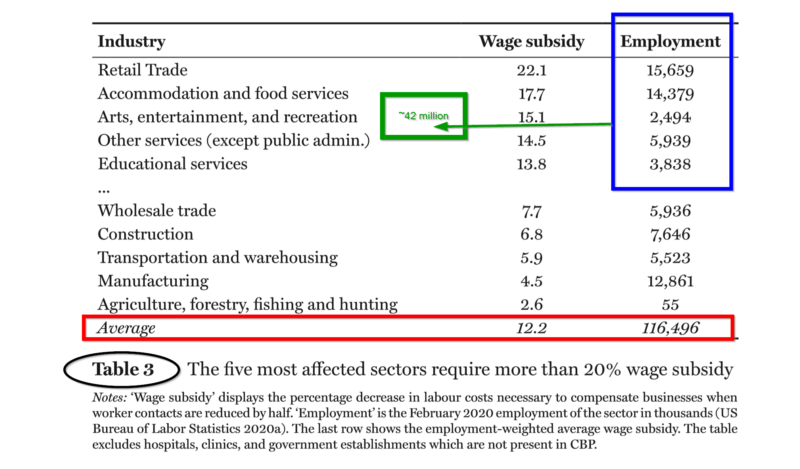Business disruptions from social distancing
- Miklós Koren and Rita Peto
- Covid Economics, Center for Economic Policy Research
- A version of this paper can be found here
- Want to read our summaries of academic finance papers? Check out our Academic Research Insight category
What are the research questions?
To describe the impact of social distancing, a theory of communication is developed and described comprehensively in this article. The focus is on the relative importance of worker interactions, the cost of those interactions and their impact on the size of wage subsidies intended as compensation for the disruption due to social distancing. The authors develop a model of communication whereby the cost of social distancing is dependent on the degree of the division of labor within sectors. The parameters of the model are estimated using data from the Occupation Information Network (O*NET; National Center for O*NET Development 2020). The database contains descriptions on just under 1000 occupations across 8 dimensions.
- What are the economic effects of social distancing interventions in terms of wage subsidies?
- Which businesses are most affected by social distancing restrictions?
What are the Academic Insights?
- Past research has focused on the economic consequences of the 1918 Spanish Flu and other viral infections throughout the world. These studies do not focus on the impact social distancing has on the economy. This study is motivated by the current emphasis on social distancing that has been implemented to reduce the spread of epidemics in a vastly different economic and social environment. The importance of direct, face-to-face communication is imperative in the production and distribution processes of numerous sectors today. Due to the current limitations and likely staggered re-opening of the economy there is a need to understand how limiting social and physical interactions affect the cost of doing business. Businesses that suffer the most are those in high-density areas in which the division of labor is important. The authors report a little over 42 million workers in the top 5 industries (see Table 3) depend on face-to-face communication and/or require close physical proximity to other workers. The model developed and then estimated from the O*NET database predicts a 13%- 22% wage subsidy for the top 5 sectors to compensate for the costs of the disruption when contacts by workers are reduced by 50%. The average for all sectors was 12.2% for a corresponding average employment number of 116 million.
- Although all sectors are affected, some are impacted due to restrictions on physical proximity but not necessarily by the need for face-to-face communication such as mining, quarrying, oil and gas occupations. However, physical proximity is not as important in finance, professional, scientific, technical and other services. Some sectors are impacted minimally across all dimensions such as fishing, hunting, printing, and related support services, as well as manufacturing. Recent estimates point out that 34% of US jobs can be performed from home (Dingel and Neiman 2020), however, for occupations and sectors for the other 66%, some are more likely to be affected by social distancing than others as indicated in Table 2. The sectors most impacted include retail; accommodations and food service sectors; arts, entertainment & recreation; and educational services.
Why does it matter?
The work presented in this article sets the stage for several new avenues of research into the topic of business disruptions as a result of policies and practices that mandate social distancing: (1) the demand side of the economy in terms of the employment impact; (2) the interaction between sectors and regions; (3) the long run changes in businesses as they attempt to build resilience to pandemic shocks, especially in terms of how easily telecommunication will substitute for face-to-face communication.
The most important chart from the paper


Abstract
Social distancing interventions can be effective against epidemics but are potentially detrimental for the economy. Businesses that rely heavily on face-to-face communication or close physical proximity when producing a product or providing a service are particularly vulnerable. There is, however, no systematic evidence on the role of human interactions across different lines of business and about which will be the most limited by social distancing. In this paper we provide theory-based measures of the reliance of US businesses on human interaction, detailed by industry and geographic location. We find that 49 million workers work in occupations that rely heavily on face-to-face communication or require close physical proximity to other workers. Our model suggests that when businesses are forced to reduce worker contacts by half, they need a 12% wage subsidy to compensate for the disruption in communication. Retail, hotels and restaurants, arts and entertainment and schools are the most affected sectors. Our results can help target fiscal assistance to businesses that are most disrupted by social distancing.
About the Author: Tommi Johnsen, PhD
—
Important Disclosures
For informational and educational purposes only and should not be construed as specific investment, accounting, legal, or tax advice. Certain information is deemed to be reliable, but its accuracy and completeness cannot be guaranteed. Third party information may become outdated or otherwise superseded without notice. Neither the Securities and Exchange Commission (SEC) nor any other federal or state agency has approved, determined the accuracy, or confirmed the adequacy of this article.
The views and opinions expressed herein are those of the author and do not necessarily reflect the views of Alpha Architect, its affiliates or its employees. Our full disclosures are available here. Definitions of common statistics used in our analysis are available here (towards the bottom).
Join thousands of other readers and subscribe to our blog.

